Note: This entry has been restored from old archives.
Preamble, or random chatter before the recipe
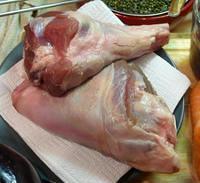
The weekend of Feb 2nd was an interesting one in the kitchen, alas it wasn’t quite high enough standard to write about. In brief, we visited our favourite local butcher on the Saturday and picked up some very fresh English lamb liver and a bag of “stewing venison.” The liver I treated as simply as it deserved, sliced about 1cm thick, flash-fried for about 2 minutes a side in a very hot cast iron pan, and served with fried onions, sweet potato mash and a pita bread. I’m now a solid fan of lamb liver, this was a simple yet 100% delicious feed. I’ll try to cover something like it in more detail in the future.
The venison was very strong in flavour, a well hung beast I’d judge. I got extremely experimental on it’s ass, in chocolate style! As an accompaniment I cooked up my first ever mole (no, not a small rodent dug up from the local common), it worked pretty well but I’ll need to give it some more practice. I think I’ll have to pick up some of the fancy chillies from the chilli-dude at Borough Market (or grow them!) The venison itself was browned with some lardons then stewed for just 1.5 hours in lots of red wine with some carrots, onions, and celery. The venison was removed and the juices and veges passed through a food mill a couple of times then boiled hard, until it got too salty and I gave in and thickened it up a little more with some cornflour. Finally some 80% dark chocolate was grated into it. This was a very rich meal, very satisfying. The idea needs more work and a couple more tries before I can write it up.
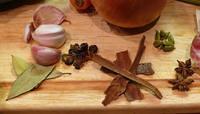
After such an experimental weekend I decided to stick to more familiar territory on the following one. Lamb shank casserole is something I can do in my sleep! We picked up some pancetta and two very juicy looking English lamb shanks from the butcher on Saturday and everything else in this recipe came from the cupboard or vegetable bowl. I decided to twist my usual flavourings a little, throwing out the usual rosemary or cinnamon and adding instead juniper berries, star anise, cardamom, and cassia bark (almost the same thing as cinnamon really.) This flavour change worked well, especially in the surplus lentil soup.
I should add some sad news. Our preferred local butcher is Hamblings, since they’re Guild-of-Q and are a BASC Game’s On supporter. We only discovered them a little while ago, we considered finding a great butcher within walking distance of home an excellent bit of luck! (If you recall, when asked for rabbit the High Street butcher could offer only Chinese rabbits, ick. Meanwhile, Hamblings knows a local guy who shoots local rabbits … it really is a much more inspiring place!) One of the local councillors provides the surprisingly modern convenience of an RSS feed of monthly council news, including summaries of planning applications and their resolutions. It was from this that I learnt of an application to turn the Hamblings site into a “hot food shop.” Shock! Misery! I confirmed this with the butcher last weekend, they’ll be around for another handful of months and when they close they won’t be opening up elsewhere. The current butcher’s father started the business in 1969! Alas, of nearly 40 years we only get to know them for their final year, oh well.
We’ll be making the best use we can of Hamblings while it’s still around. We picked up more lambs liver (dinner last night) and a couple of very nice looking sirloin steaks (dinner tonight) today. Plus we ordered a fresh hare for next weekend, that’s going to be fun!
Anyway, enough chatter, I’ve got a recipe to write up…
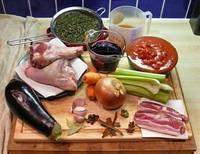
Ingredients
Serves: 2 Large Dinners, plus 8 “leftover” 280g serves of lentils.
To serve more people simply add more shanks, the limit depends on the size of your casserole! I could add two more shanks to mine without a problem. This means you’ll add less water later and will probably want to make up the difference after the shanks are removed, otherwise the lentils will be too dry in the end.
- 2
- lamb shanks (these shanks were 450g each)
- 1 tbsp
- light olive oil (about 10g)
- 135g
- cubed pancetta (lardons or streaky bacon will suffice)
- 1 large
- diced brown onion (225g prepared, 260g before)
- 3 sticks
- halved and sliced celery (180g prepared, 190g before)
- 2 small
- roughly cubed carrots (100g prepared, 110g before)
- 1 small
- roughly cubed eggplant (270g prepared, 280g before)
- 4 cloves
- sliced garlic (20g prepared, 22g before)
-
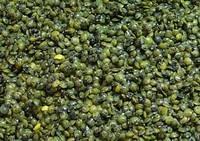
Puy Lentils - 350ml
- decent dry red wine (a cask of Banrock Station!)
- 800g
- organic chopped tomatos in rich juice
- 500ml
- light beef stock
- 2 stars
- star anise
- 5 small
- pieces of cassia bark
- 10
- cardamom pods
- 10
- crushed juniper berries
- 4
- small bay leaves
- 500g
- puy lentils (soaked for 10 mins, then rinsed and drained)
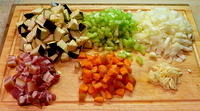
I’m not going to detail the, minimal, preparation any further. The basic descriptions above combined with the photo to the left should provide all the detail required.
The first thing to do it pull out a heavy casserole, I own and love a blue 24cm Chasseur which is the vehicle for almost all my slow cooked recipes. For years I tried this sort of thing with lesser stockpots and saucepans and, while they can do the job, they just aren’t as easy to work with. Stick the casserole on a medium heat and add the olive oil, heat until it runs freely (but not so hot that it smokes) then toss in the pancetta. This should merrily sizzle and pop but not smoke, toss the sizzling pig until golden brown. Now the lamb shanks, ideally at room temperature and patted dry with a paper-towel, make some space amongst the pancetta pieces and place the shanks fat-end down. Let them sit and brown for a couple of minutes, then put them onto their sides and do the same, turn and repeat until the shanks have a good all-round browning (except where the curve of the meat/bone make this impossible of course!) The browning probably takes about 15 minutes all up. With this done put the shanks aside in a dish but keep the lardons in the casserole.
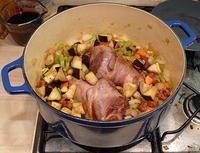
The vegetables come next. Toss the onion, celery, and carrot into the pot. This should be sizzling quietly, like quiet radio static (“What’s that!?” Says the digital radio generation.) Keep the veggies on the move so that they’re evenly heated and keep at it until they’re translucent and just beginning to brown. At this point the eggplant and garlic goes in. Again, keep things on the move until the eggplant has absorbed any excess oil and is starting to soften up, this should only be about 5 minutes. Add all the spices, toss, and then nestle the shanks into the vegetables, shifting veggies out of the way so the shanks are as low as possible.
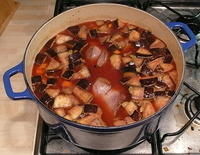
In with 250ml of wine! Note, keep 100ml for later. In with the stock! In with the tomato! Now top the casserole up with water until the liquid level is just level with the tops of the shanks (photo left.) This took a litre of water for me, but will depend on the size of your shanks and your pot. Give everything a good stir, making sure the shanks stay low in the water. Don’t worry that the liquid is rather watery, we’ll deal with this later.
Bring the liquid to just barely simmering, put the lid on the pot, and leave for 30 minutes. I suggest checking every five minutes three times to ensure the simmer is maintained. If it gets too eager you must reduce the heat. After the first thirty minutes are up give the casserole a good stir and turn the shanks. Do the same thing twice more at 30 minute intervals then after the next 30 minutes (so 2 hours all up) we’re done.
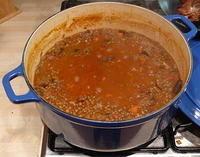
Pull the shanks out of the casserole and put them aside in a bowl. Now push the flame under the casserole right up and in with the lentils! We want the liquid in the casserole bubbling pretty furiously, but not so much that it’s making a mess of your stove. Keep it like this until the liquid reaches a nice soupy texture, this is achieved by reduction and also by starches from the lentils. My casserole had lost about 1 inch (2.5cm) or liquid by this stage. Now stir in the extra 100ml of wine, this adds a desirable piquancy to the soup. Reduce the heat to a gentle simmer and keep on this until the lentils are done as you prefer, I gave them another 15 minutes. I like my lentils al-dente, especially puy lentils which will retain some of their lovely mottling if you don’t over-cook them. That’s really up to your own tastes though, stop the heat when the lentils have reached whatever you consider to be their perfect texture. Taste and add salt if desired, carefully.
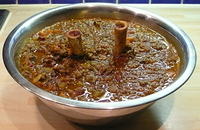
We’re almost done now. The last thing to do is sink the shanks back into the lentils for about 10 minutes. This will re-heat the shanks and let the lentils cool a bit.
Serve by dropping a shank into a good sized bowl, ladling over as much lentil soup as desired, and topping off with some good EVOO and fresh ground pepper. A generous sprinkle of chopped parsley would go well I think, or even a gremolata, alas we didn’t have any parsley. Enjoy with a rich, dry red, maybe the one you cooked with — you do cook with a wine that is good enough to drink, right? I’m actually using a Banrock Station cask red for cooking at the moment, but prefer a richer wine to go with this meal. (Banrock Station was my preferred cooking plonk back in Sydney and a wine I’m quite happy to have a glass of. The price here compared to Sydney is scary, but that’s just London for you and the wine has travelled half way around the globe after all, bad “food mile” karma.)
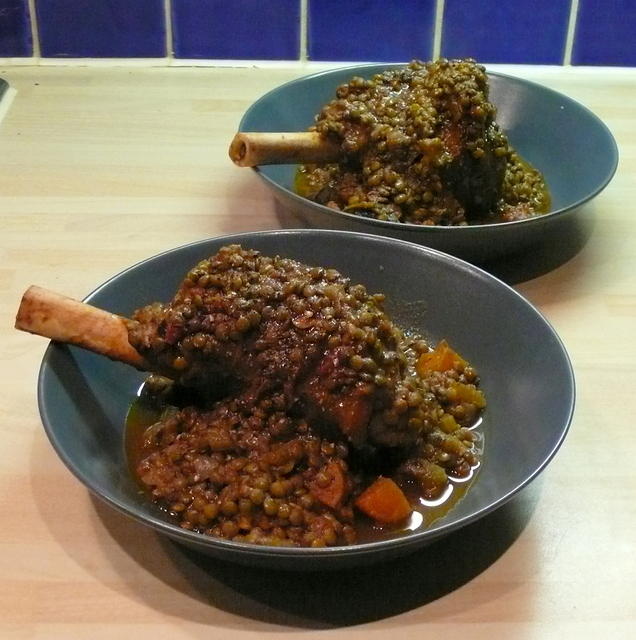
Nutrition
In the end the lentil “soup” came to 2.9kg and per 300g serve has ~310 Calories. That’s taking into account all the ingredients above, assuming not much alcohol was lost from the wine, and that the lamb shanks added about 50g of fat to the soup (all erring on the greater side I think.) The other caveat is the pancetta, from one piece to another the fat content can vary wildly. So as usual, the nutritional details are a rough estimate (as you must realise these things always are!)
| Lentil Soup: 300g | |
|---|---|
| Thing | Value |
| Energy | 310 kcal |
| Carbohydrate | 34.5g |
| Protein | 16.8g |
| Fat | 9.2g |
| Sat | 2.0g |
| Mono | 4.4g |
| Poly | 0.7g |
| Dietry Fibre | 8.0g |
I’ll leave it up to the reader to decide how many calories a lamb shank has, it’s simply too variable! After portioning out 300g of lentils for each shank we had leftovers to make 8 280g serves of soup, so 290 kcal per serve (+44 with a 5g drizzle of EVOO.)
There’s a few more photos of the cooking and ingredients in the
Lamb Shanks with Lentils photo album.
I made this kind of but only used the shanks onions, potatoes, carrot, celery, bay leaves garlic salt & pepper & a bit of red wine and a cinnamon stick. It was really good and I’m not that good a cook (usually don’t like my own cooking although others are more complimentary). Yvan’s order in timing the cooking is excellent. Thanks couldn’t of done it without ya. Anyway try it you’ll like it. I cooked it on a 37 degree celcius day (I’m from OZ)and I reckon it’s a cooler/winter day kinda food. But hey it’s really really good. Cheers! One question though why flour the shanks? Forgot to do this but still very nice!
Howdy,
Yeah, it’s a good winter dish this one. I moved from OZ to the UK a couple of years ago… so there’s a lot more room in the year for winter food in my life now 😉
You can do basically anything with the core recipe, throw in whatever you have or whatever takes your fancy. That’s the great thing about casseroles and stews.
I think you meant to comment on the other lamb shank recipe, “Lamb Shank Casserole” (http://yvan.seth.id.au/Entries/2006/09/lamb-shank-casserole/). This is actually the second lamb shank one I wrote up and it doesn’t mention flouring the shanks! 🙂
All the same, the answer to “why flour” is: “no good reason”… it’s something that a lot of cooking books tell you to do and if a justification is given it is usually “sealing the meat”. I’ve come to think this is a load of bull, after 2 or 3 hours cooking a bit of flour isn’t going to have achieved anything at all! A more reasonable justification is that the flour can help thicken the sauce, but thickening can be done at the end if it is required. I think now that it is best to not flour meat before stewing/casseroling, so forgetting to do it is great.